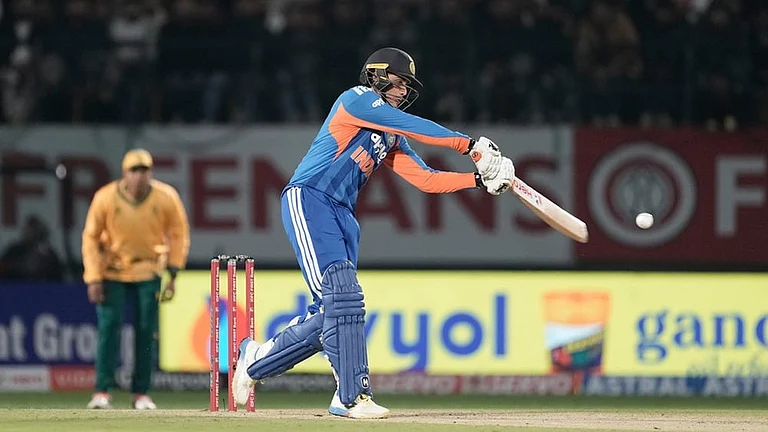Perhaps it takes a clairvoyant to call the closest of electoral fights accurately. “Didi has taken a great risk,” a Trinamool Congress MLA from East Midnapore district had said a few days before the second phase of the assembly elections on April 1, in which Mamata Banerjee’s constituency, Nandigram, was to vote. Requesting anonymity, he had said: “This one decision to take Suvendu head-on in Nandigram has saved the party’s district unit from a vertical split after his defection and, as far as I understand, has bolstered the morale of the party’s workers and leaders across the state. I won’t be shocked if Didi’s show of confidence helps us return to power, but she ends up losing here.”
His positive prognostication, with that one foreboding, came true on May 2, when the TMC returned to power with 213 of the 294 seats in the assembly and a 48 per cent share of the polled votes—the party’s best performance ever. Yet Mamata Banerjee lost from Nandigram by a slender margin of 1,956 votes after a series of drama over the recounting of votes.
Even in East Midnapore district—a bastion of the Adhikary family comprising Suvendu’s father, Sisir, and brother, Dibyendu—the TMC won 10 of the 16 assembly seats. While stating that the party will challenge the Nandigram election result, Mamata also made a remark hinting that choosing Nandigram specifically, and thereby accepting the BJP’s challenge of contesting from one seat, was a calculated move. “I would rather ignore what happened in Nandigram. Sometimes, small sacrifices are required for a great gain,” she said. It was the political equivalent of sacrificing a symbolic pawn on the electoral chessboard to corner the opponent—in short, a masterstroke.
ALSO READ: Positive Result, Negative Time

Still, by ‘sacrifice’, Mamata probably meant a blot on her own electoral career—this was her first defeat since 1989. After having been chosen the leader of the TMC’s legislative party, all she needs is to get elected from any constituency within six months. The party will choose the seat in a few days.
ALSO READ: Broken Arrow
The assembly election of 2021 was, in many senses, a battle of nerves and body language, of creating a potent perception. And Mamata Banerjee scored high in these, say most political observers. Prime Minister Narendra Modi and Union home minister Amit Shah repeatedly bloviated that they were going to form the government with over 200 seats. Mamata urged people to give her more than 200 seats so that the BJP—as is their wont—couldn’t topple her government by poaching on her party’s MLAs. Her appeal carried more weight.

Political leaders also say that beyond these rounds of mind games, there lurked a larger trend of anti-BJP polarisation in favour of the TMC that helped the party script such a historic mandate. This is quite evident from how the TMC’s voteshare rose in a matter of two years from 43.3 per cent in the Lok Sabha elections of 2019 to 48 per cent this time. Ranged against the BJP was not only the TMC’s spirited campaign that drew liberally on nativist sentiments, but also the appeals of prominent civil society members who openly called for defeating the BJP. Small political parties, rights organisations and citizens’ platforms brought up a strident anti-BJP rear. “It’s clear that a section of traditional Left votes went to the TMC this time,” says psephologist Biswanath Chakraborty, a professor of political science at Rabindra Bharati University in Calcutta.
ALSO READ: What Did I Do!

However, two large sections of the electorate have stood Mamata Banerjee in spectacular stead—women and Muslims. Both were expected. There was a great deal of buzz among journalists and psephologists during the campaign that women in most places favoured Mamata, beguilingly touted as banglar meye (Bengal’s daughter). The results also reveal that the Congress and the Left had completely lost their traditional, minority votes in Muslim-dominated areas. Unbelievably, the Congress was wiped out of its strongholds of Malda and Murshidabad, both Muslim-majority districts. In the 41 seats in the state’s three Muslim-majority districts—Malda, Murshidabad and Uttar Dinajpur (two seats saw no polling after the death of candidates)—the TMC bagged 33, while the BJP got eight. It was a neat division along religious lines.
ALSO READ: All These Small, Left-Leaning Flowers
It was also evident that despite the state BJP’s intense campaign that raucously promised to protect West Bengal “from turning into a hub of jehadis”, the party failed to polarise the majority of Hindus on communal lines. In the districts around Calcutta, the TMC won many seats where Muslims had negligible presence, and who thus couldn’t have influenced the electoral outcome.
Some of the broad trends of the results revealed that the BJP failed miserably in Calcutta—losing all 11 seats—and in its neighbouring districts of Howrah, South 24-Parganas, North 24-Parganas, Hooghly and Purba Bardhaman.
ALSO READ: The Other Pinarayi
The districts of Cooch Behar and Alipurduar in North Bengal remain their stronghold, with more bastions in the district of Bankura in southwestern Bengal and the Bankura-bordering Arambagh sub-division of Hooghly district. In the heart of South Bengal, they retained their base only in the Matua-dominated areas of Nadia and North 24-Parganas. The Matuas are migrants from Bangladesh who have been votaries of the Citizenship (Amendment) Act since 2018. It is mostly areas dominated by people from the Scheduled Caste communities that the BJP got most of their seats from.

Despite such a resounding victory, Mamata Banerjee may not enjoy a trouble-free tenure. With 77 assembly seats, the BJP is now the only opposition party in the state assembly. The Left and the Congress have drawn a complete blank—an ignominious nadir since the first assembly polls held in 1951-52 in independent India. And the BJP has made it abundantly clear that they are going to be a formidable opposition, especially with the Union government and the party’s national leadership standing by the state’s workers.
ALSO READ: Captain @99
While speaking to the media a day after the results, Mamata Banerjee, too, did not hide the fact that she would have preferred more Left and Congress MLAs in the Opposition benches instead of those from the BJP.


As reports of post-poll political violence targeting BJP supporters came pouring in since the night of May 2, BJP national president J.P. Nadda rushed to Bengal on May 4 to meet the victims of such atrocities. PM Modi also called Governor Jagdeep Dhankhar to express concern. The party announced a nationwide protest on May 5, the day of Mamata Banerjee’s swearing-in.
Khela hobe—game’s on—was the wildly popular electoral slogan of the TMC. Now, that game is over, and the BJP defeated hands down. But there are indications even before the start of Mamata’s new term that a new, protracted game—a bare-knuckle fight—is about to make its debut in Bengal.
ALSO READ
By Snigdhendu Bhattacharya in Calcutta









_.jpg?auto=format%2Ccompress&fit=max&format=webp&w=768&dpr=1.0)
















